Tendons
Tendons are fibrous cords, similar to a rope, and are made of collagen. They have blood vessels and cells to maintain tendon health and repair injured tendon. Tendons are attached to muscles and to bone. As the muscle contracts it pulls on the tendon and the tendon moves the bone to which it is attached as well as any joints it crosses.
Jump to:
Finger Flexors
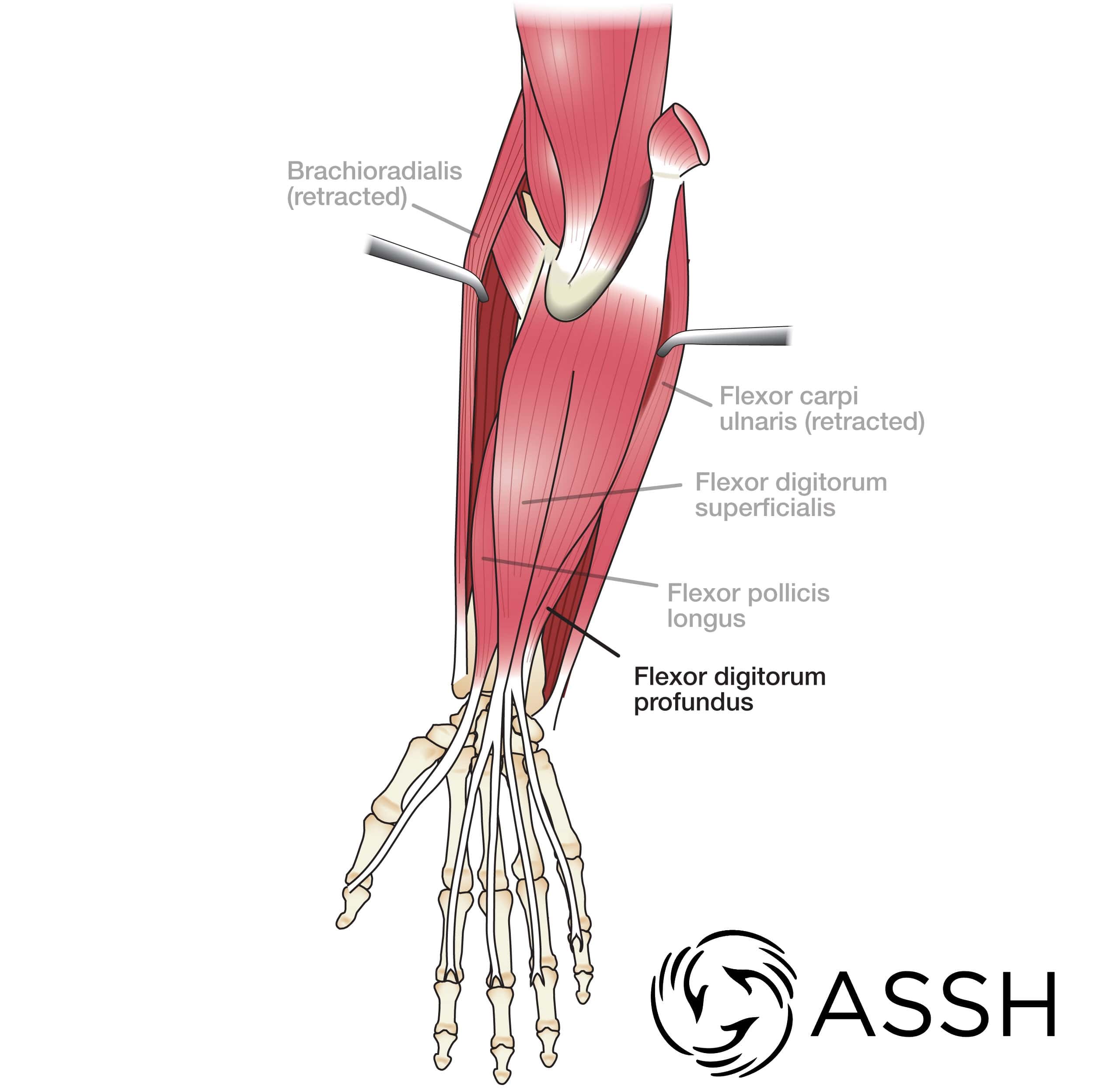 Flexor digitorum profundus (FDP) tendons
Flexor digitorum profundus (FDP) tendons
FDP tendons help bend the index, middle, ring, and small fingers at the fingertip joint. The muscle that moves these tendons is a common muscle belly shared by all the fingers. The muscle belly divides into 4 tendons. They run down the forearm and within the carpal tunnel. The four tendons glide in sheaths along the hand and fingers and insert into the fingertip bone. These tendons run closer to the bone compared to the rest of the flexors in the hand and fingers. Learn more about flexor tendon injuries.
Flexor digitorum superficialis (FDS) tendons
FDS tendons help bend the index, middle, ring, and small fingers at the middle finger joint. They are powered by a common muscle belly shared by all the fingers, which divides into 4 tendons. They travel down the forearm and within the carpal tunnel. Just like the flexor digitorum profundus tendons, these tendons glide in sheaths along the fingers and the hand. At the level of the fingers, each tendon splits into 2 separate cords and then insert into the middle bone of the finger on either side of the flexor digitorum profundus tendon that runs farther down the finger.Finger Extensors
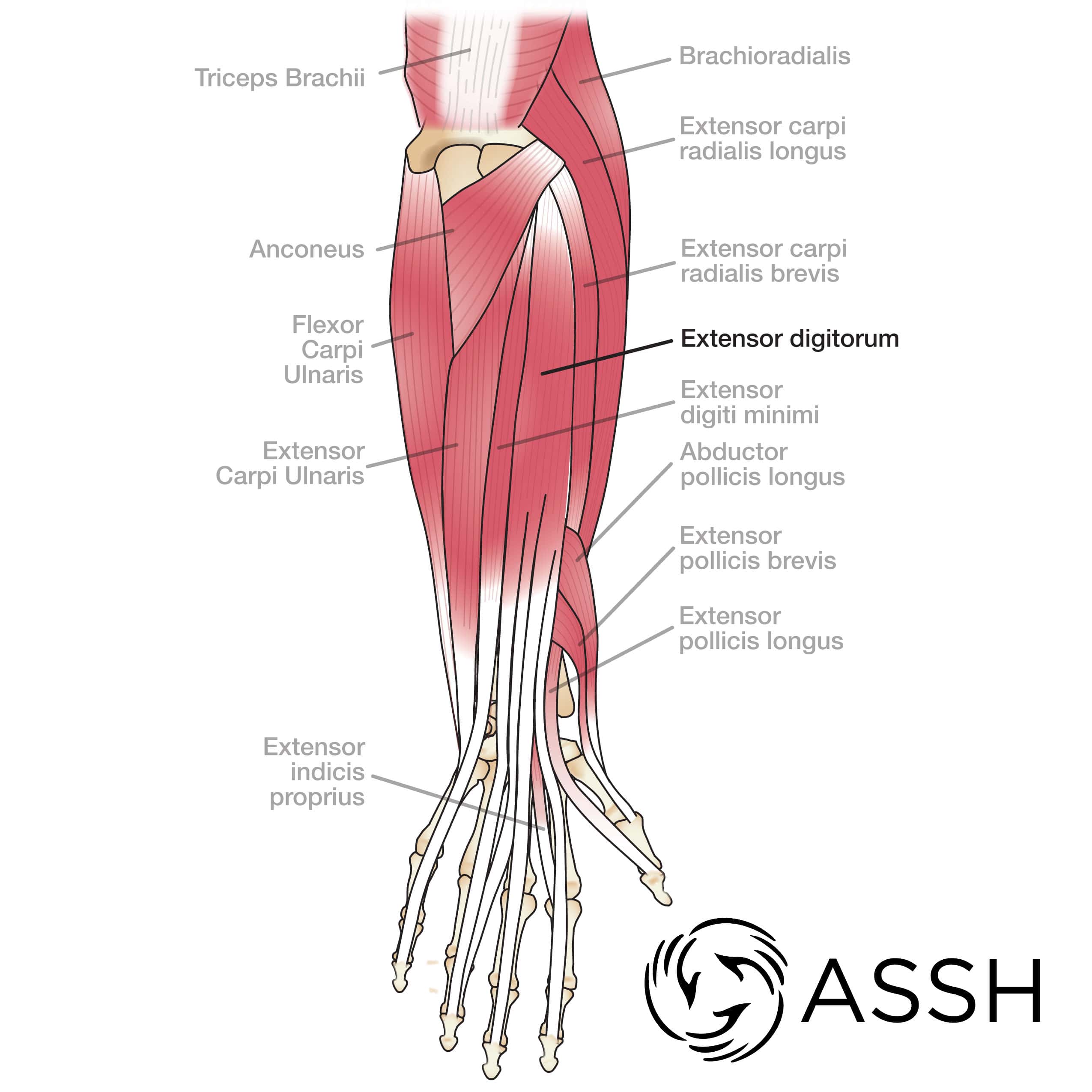 Extensor digitorum communis (EDC) tendons
Extensor digitorum communis (EDC) tendons
EDC tendons straighten the index, middle, ring and small fingers. A common muscle belly is shared by all the fingers. The tendons travel down the forearm through a tough band of tissue on top of the wrist. The band of tissue, or retinaculum, holds the tendons in place but allows them to slide up and down the arm. The four tendons then continue along the back of the hand and onto each finger. In the finger, the ends of other tendons that start in the hand join with them to make the fingers move. Together, these combined tendons extend the fingers at the three finger joints.
Extensor digiti minimi (EDM) tendon
The EDM straightens the small finger. It works with the extensor digitorum communis to the small finger. The muscle belly is in the forearm. The tendon travels through a tough band or retinaculum at the wrist and then into the hand. The band of tissue, or retinaculum, holds the tendons in place but allows them to slide up and down the arm. It works with other tendons that attach to the dorsum or back of the finger to straighten the three small finger joints. Fewer than 50% of people are born with this tendon.
Extensor indicis proprius (EIP) tendon
The EIP tendon straightens the index finger. It works with the extensor digitorum communis to the index finger. It has its own muscle belly in the forearm and then, as it becomes a tendon, it travels through a tough band, or retinaculum, in the wrist. The band of tissue, or retinaculum, holds the tendons in place but allows them to slide up and down the arm. It travels down the hand and attaches to the back of the index finger to straighten the three index finger joints.
Thumb Tendons
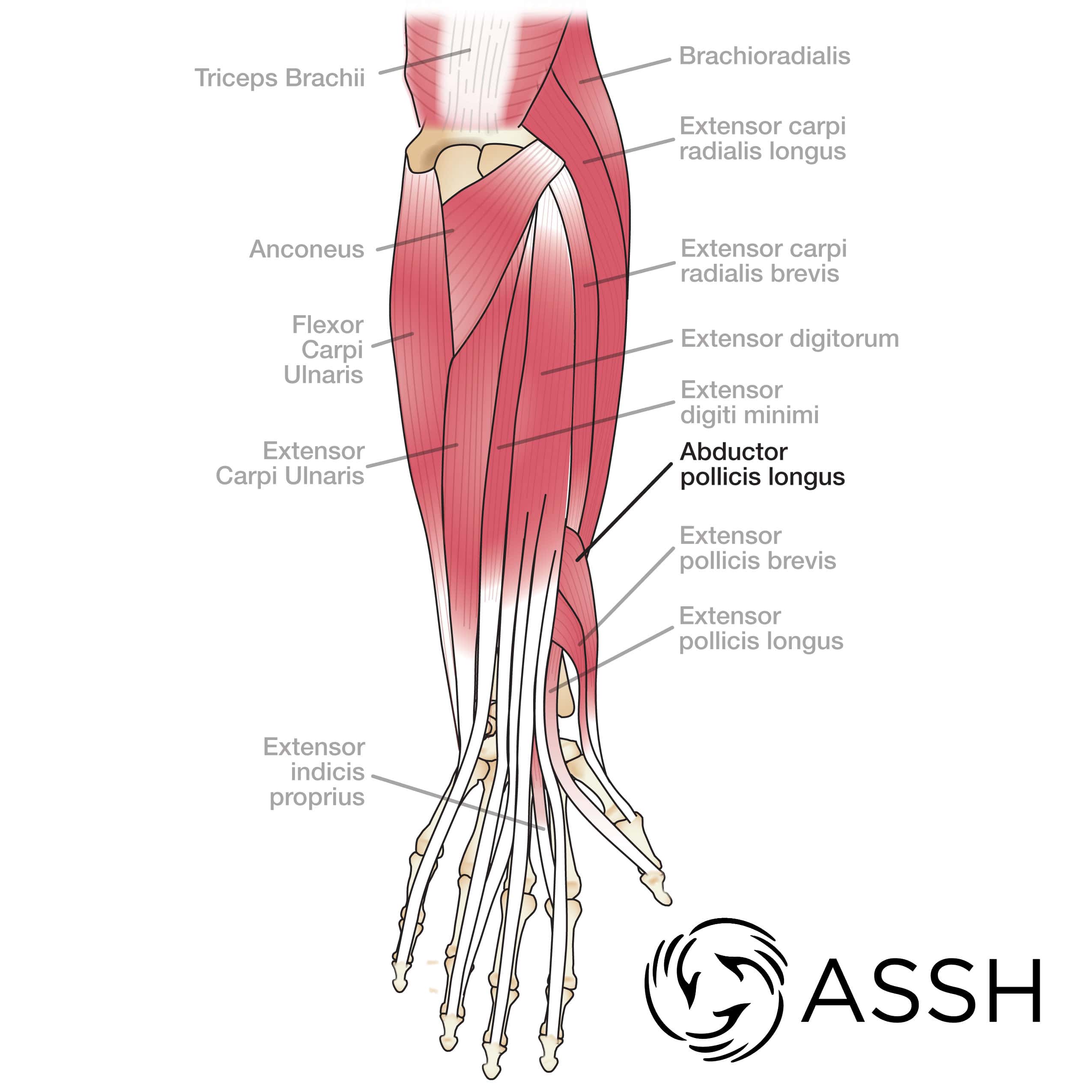 Abductor pollicis longus (APL) tendon
Abductor pollicis longus (APL) tendon
The APL tendon runs on the radial side of the wrist (the side the thumb is on). Its muscle belly is in the forearm and then travels inside a tough band, or retinaculum, across the wrist. The band of tissue, or retinaculum, holds the tendons in place but allows them to slide up and down the arm. It attaches to the metacarpal bone of the thumb and helps pull the thumb away from the rest of the hand. This tendon along with the extensor policies brevis tendon can get inflamed and painful. The name for when these 2 tendons get inflamed is de Quervain’s Syndrome.
Flexor pollicis longus (FPL) tendon
The FPL tendon bends the thumb. It is unique to humans. It starts as a muscle in the forearm and then travels as a tendon in the wrist through the carpal tunnel. It is then covered by a tunnel, or sheath, and inserts into the most distal (farthest from your body) bone in the thumb.
Extensor pollicis longus (EPL) tendon
The EPL straightens the most distal (farthest from your body) joint of the thumb. Its muscle belly is in the forearm and the tendon travels along the wrist and enters the third compartment of the band that holds the tendons in position at the wrist. It then travels around a prominent part of the radius bone that acts like a pulley. It is called Lister’s tubercle. The tendon then attaches to the most distal bone in the thumb.
Extensor pollicis brevis (EPB) tendon
The EPB tendon, along with the APL, also takes the thumb away from the hand. The EPB tendon is in the forearm and then runs along the radial side of the wrist. This tendon also travels in the first compartment of the band that holds the tendons in position at the wrist. It is inflamed in the conditioned called de Quervain’s Syndrome.
Wrist Tendons
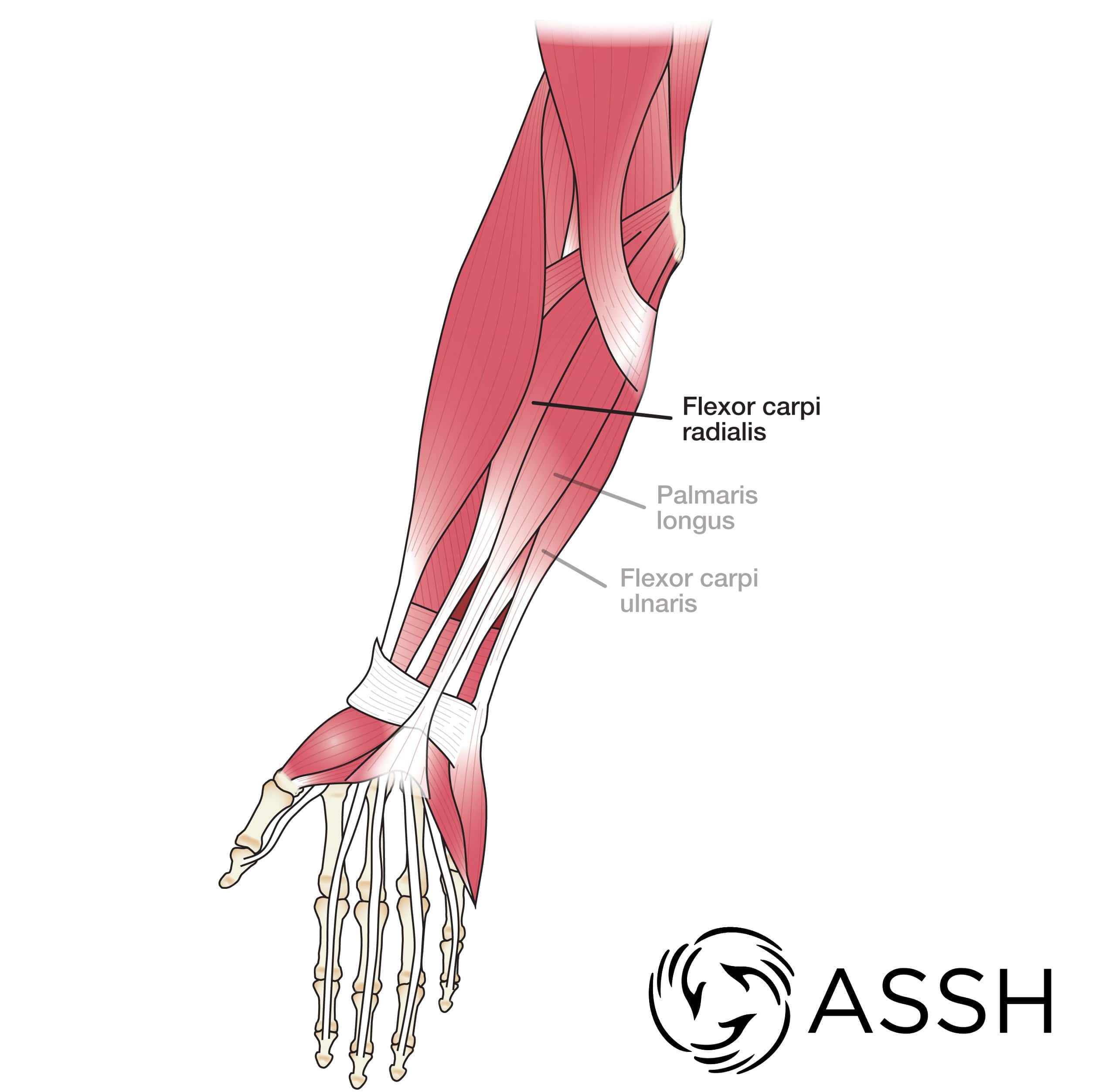 Flexor carpi radialis (FCR) tendon
Flexor carpi radialis (FCR) tendon
The FCR tendon is one of two tendons that bend the wrist. Its muscle belly is in the forearm and then travels along the inside of the forearm and crosses the wrist. It attaches to the base of the second and third hand bones. It also attaches to the one of the wrist bones, the trapezium.
Flexor carpi ulnaris (FCU) tendon
The FCU tendon is one of two tendons that bend the wrist. Its muscle belly is in the forearm. The tendon travels along the inside of the forearm on the side of the small finger and crosses the wrist. It attaches to the wrist bone, the pisiform, and as well as the 5th hand bone.
Palmaris longus tendon
The palmaris longus tendon is a tendon with very little function in the hand. About one fourth of the population does not have this tendon. The rest have varying sizes of this tendon. Its muscle belly is in the forearm. It travels into the wrist and joins the fascia in the palm. This tendon is often used to repair other tendons.
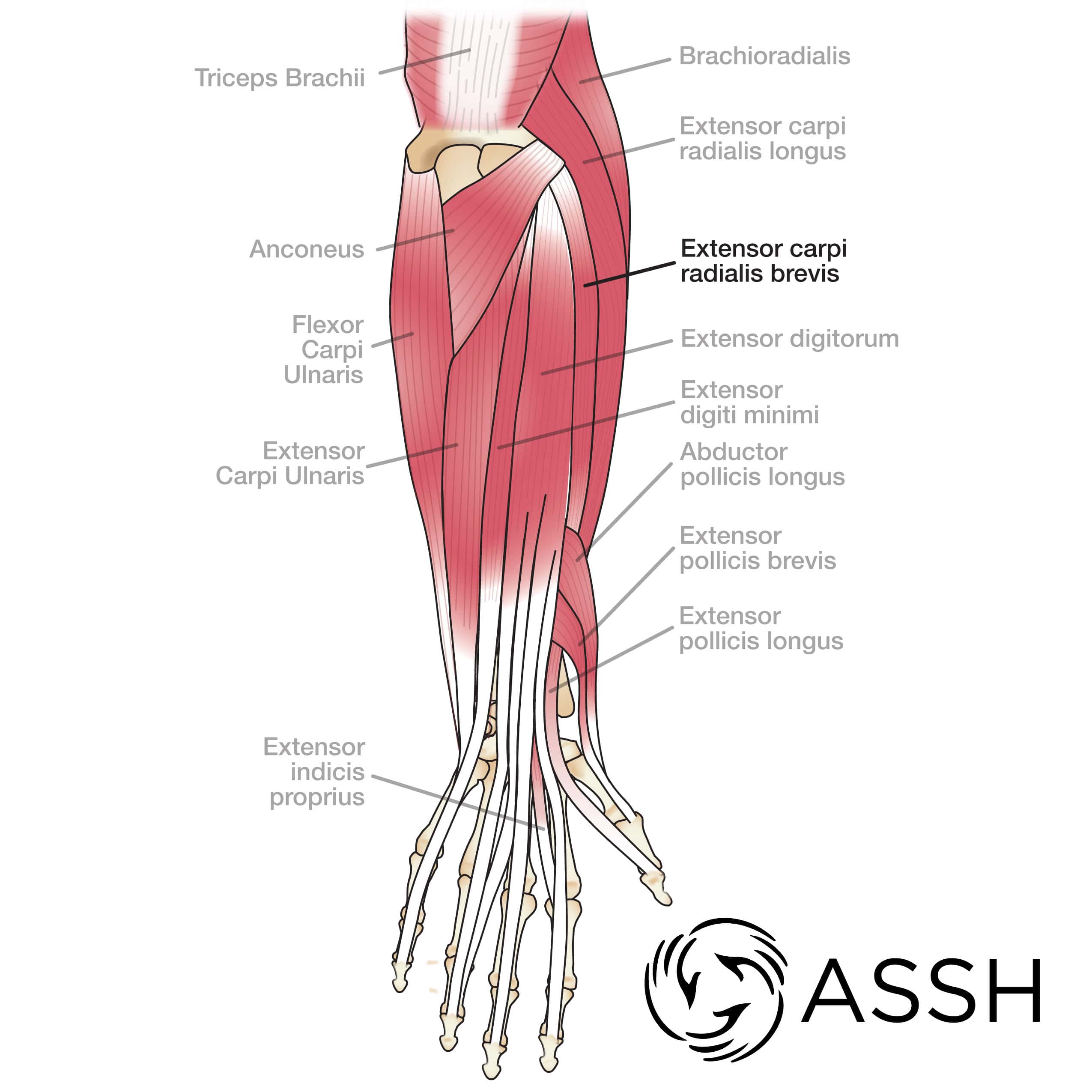 Extensor carpi radialis brevis (ECRB) tendon
Extensor carpi radialis brevis (ECRB) tendon
The ECRB tendon is one of 3 tendons, including ECRL and ECU, which act together to bend back the wrist. Its muscle belly is in the forearm and then travels to the thumb side of the wrist on the back part of the forearm. Along with the ECRL, it attaches to the base of the hand bones. It is shorter and thicker than the ECRL.
Extensor carpi radialis longus (ECRL) tendon
The ECRL tendon acts along with the ECRB and ECU to bend back the wrist. ECRL and ECRB also help bend the wrist in the direction of the thumb. Its muscle belly is in the forearm. It is thinner and longer than ECRB. It travels along the back aspect of the forearm and attaches to the base of the hand bones.
Extensor carpi ulnaris (ECU) tendon
The ECU tendon works along with the ECRL and ECRB to straighten the wrist. It differs from these other two tendons in that it moves the wrist in the direction of the pinky. Its muscle belly is in the forearm. The tendon travels along the back forearm, through a groove in the ulna, and attaches to the base of the hand bones.
Elbow Tendons
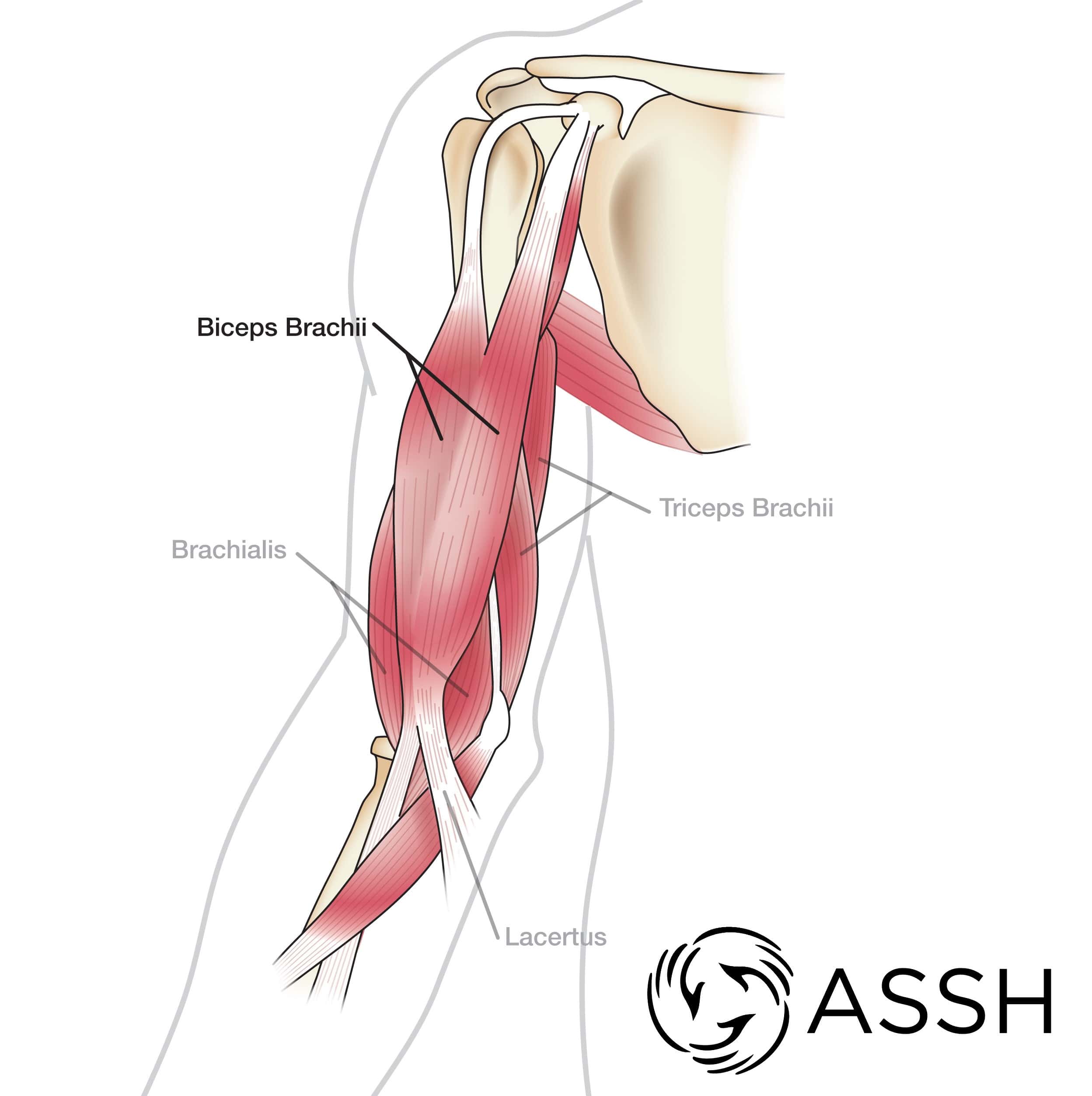 Biceps tendon
Biceps tendon
The biceps muscle has tendons on each end of the muscle. At the shoulder, the two tendons both attach to the large flat bone in the upper trunk called the scapula. The muscle belly then crosses the entire upper arm and separates into two tendons. One tendons inserts onto the forearm bone, the radius, and the second spreads out to join the fascia along the upper part of the forearm. The tendons have 2 functions: to bend the elbow and to turn the palm of the hand towards the sky.
Triceps tendon
The triceps tendon is wider than most of the other tendons in the upper extremity. Its muscle belly is on the back aspect of the upper arm. There are 3 muscle bellies that join to make this tendon. It forms a tendon near the elbow and attaches to the most bony, prominent aspect of the back elbow. The tendon straightens the elbow.
Brachialis tendon
The brachialis tendon works along with the biceps and brachioradialis to bend the elbow. The muscle belly is in the upper arm and forms a thick tendon that attaches to the inner aspect of the elbow. Its sole function is to bend the elbow.
Brachioradialis tendon
The brachioradialis tendon bends the elbow like the brachialis and biceps. Unlike these others, the muscle belly is mostly in the upper part of the forearm and the tendon attaches to the wrist. In addition to flexing the elbow it can also help rotate the wrist. (See image in Wrist Tendons)
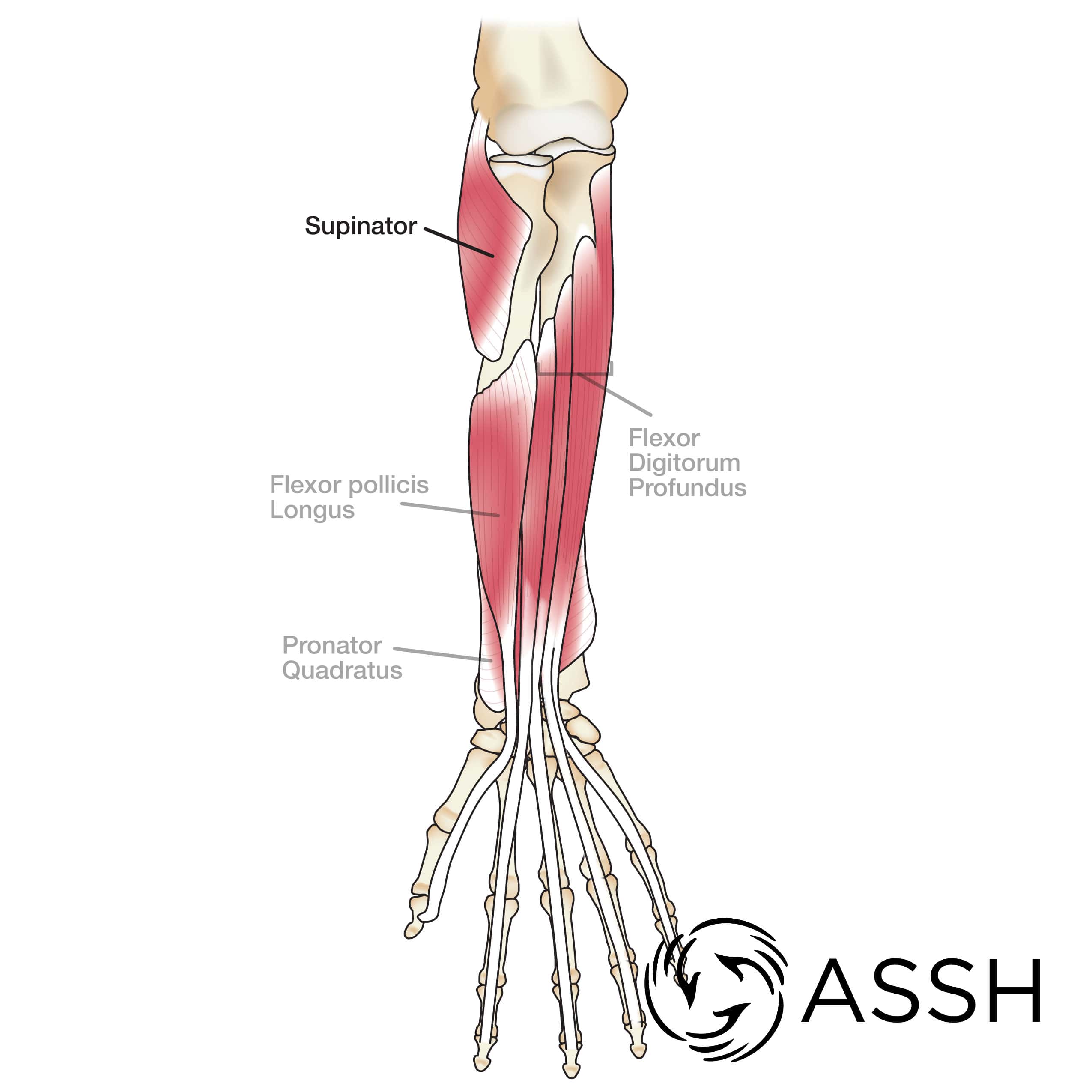 Supinator tendon
Supinator tendon
The supinator tendon is at the origin of this short, broad muscle. The tendon attaches on the humerus just near the elbow. The muscle then goes on to attach to the radius. The main action is to rotate the hand